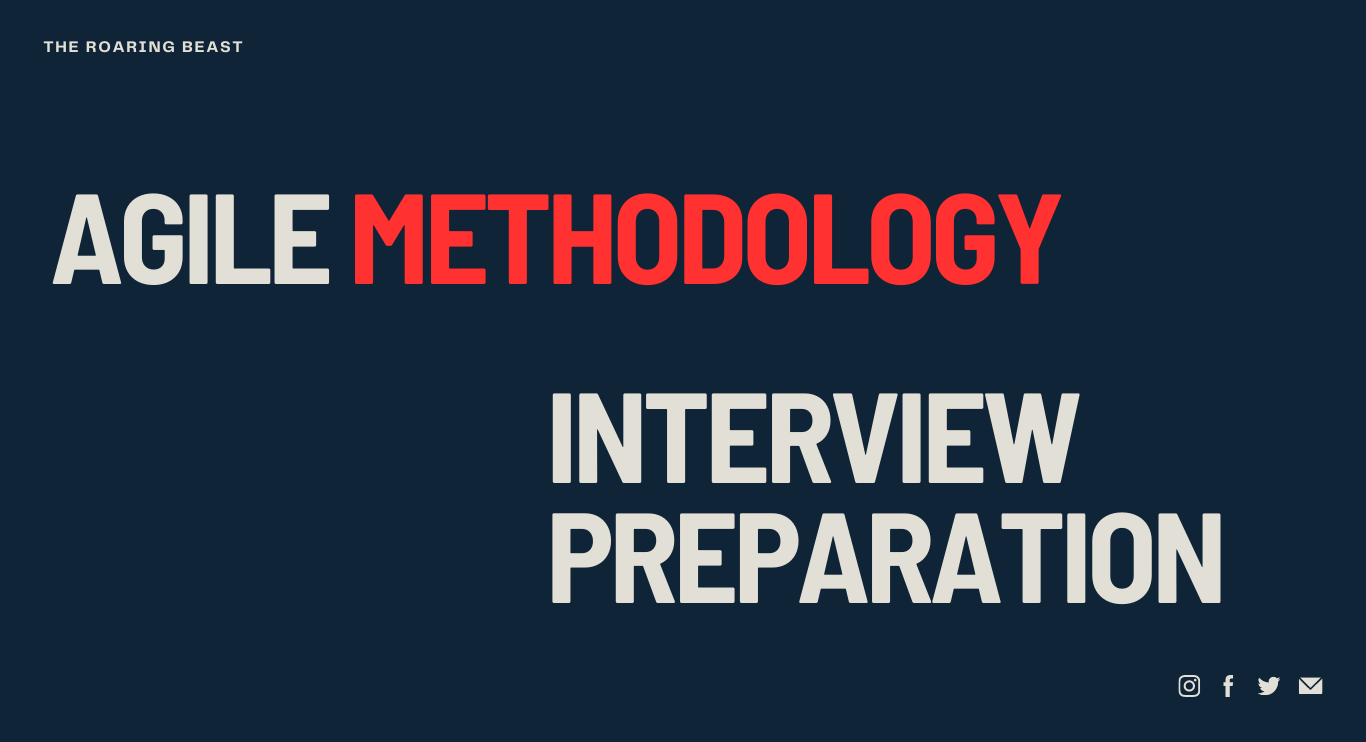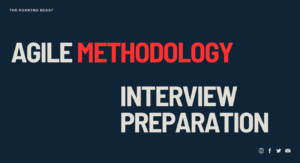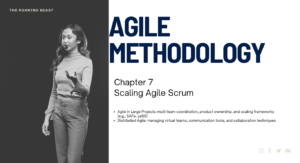Here are some common Agile Scrum interview questions along with answers
- How does Scrum address changing requirements during a project?
Answer: Scrum handles changing requirements through its iterative approach and flexibility. The Product Owner constantly reviews and prioritizes the product backlog, and the team adapts their work during each sprint. Changes can be accommodated through re-prioritization and adjustments to the sprint backlog. - What is the difference between a product backlog and a sprint backlog?
Answer: The product backlog is a prioritized list of all desired features, enhancements, and bug fixes for the product. It represents the entire scope of work. The sprint backlog, on the other hand, is a subset of the product backlog, containing the user stories and tasks selected for a specific sprint. - How do you estimate user stories in Agile Scrum?
Answer: Agile Scrum commonly uses story points for estimating user stories. Story points are a relative measure of the effort required to complete a user story. The team collectively assigns story points based on factors like complexity, risk, and effort. Planning Poker is a popular technique for collaborative estimation. - How does the Scrum Master contribute to the team’s success?
Answer: The Scrum Master plays a crucial role in facilitating the Scrum process. They ensure adherence to Agile principles, coach the team on Agile practices, remove any impediments that hinder progress, and foster a collaborative and self-organizing team environment. - How does Scrum promote collaboration within the team?
Answer: Scrum promotes collaboration by encouraging regular interactions through ceremonies like daily stand-ups, sprint planning, sprint reviews, and retrospectives. It emphasizes cross-functional teamwork, open communication, and collective decision-making, leading to increased collaboration and knowledge sharing. - How does Scrum handle risks and issues during a project?
Answer: Scrum addresses risks and issues by making them transparent and addressing them promptly. The daily stand-up allows team members to raise any concerns, and the Scrum Master helps remove any obstacles. Retrospectives provide a forum to identify and address issues, leading to continuous improvement. - How does Scrum measure progress and project success?
Answer: Scrum uses various metrics to measure progress, such as sprint burndown charts, velocity, and the increment delivered at the end of each sprint. Success is measured by the ability to deliver value to customers, meeting sprint goals, and continuously improving team performance and customer satisfaction. - How does Agile Scrum handle quality assurance and testing?
Answer: Agile Scrum promotes quality through practices like test-driven development, continuous integration, and regular testing. Quality assurance activities are integrated throughout the development process, with testers working closely with the development team to ensure that the product meets the defined acceptance criteria. - What is Agile Scrum, and why is it used?
Answer: Agile Scrum is an iterative and incremental approach to project management and product development. It is used to deliver value to customers faster, accommodate changing requirements, and improve team productivity and satisfaction. - What are the roles in Scrum, and what are their responsibilities?
Answer: The roles in Scrum are Product Owner, Scrum Master, and Development Team. The Product Owner defines the product vision and manages the product backlog. The Scrum Master facilitates the Scrum process, and the Development Team delivers the product increment. - What are the core values of Agile?
Answer: The core values of Agile are individuals and interactions over processes and tools, working software over comprehensive documentation, customer collaboration over contract negotiation, and responding to change over following a plan. - How does Scrum address changing requirements during a project?
Answer: Scrum handles changing requirements through its iterative approach and flexibility. The Product Owner constantly reviews and prioritizes the product backlog, and the team adapts their work during each sprint. - What is a user story in Agile Scrum?
Answer: A user story is a short, simple description of a feature or functionality from an end-user perspective. It captures the “who,” “what,” and “why” of a requirement and serves as a basis for planning and development. - How does Scrum promote collaboration within the team?
Answer: Scrum promotes collaboration by encouraging regular interactions through ceremonies like daily stand-ups, sprint planning, sprint reviews, and retrospectives. It emphasizes cross-functional teamwork, open communication, and collective decision-making. - What is the purpose of a sprint review?
Answer: The purpose of a sprint review is to inspect the increment delivered at the end of a sprint and gather feedback from stakeholders. It provides an opportunity to demonstrate the work completed and gather input for future iterations. - What is the difference between velocity and capacity in Scrum?
Answer: Velocity is a measure of the amount of work a team can complete in a sprint, based on the user story points completed. Capacity, on the other hand, is the amount of work a team can handle in a sprint based on their available time and resources. - How does Scrum handle risks and issues during a project?
Answer: Scrum addresses risks and issues by making them transparent and addressing them promptly. The daily stand-up allows team members to raise any concerns, and the Scrum Master helps remove any obstacles. Retrospectives provide a forum to identify and address issues, leading to continuous improvement. - What is the Definition of Done in Scrum?
Answer: The Definition of Done is a shared understanding within the team of what criteria must be met for a user story to be considered complete. It includes quality assurance, testing, documentation, and any other activities required to deliver a shippable product increment. - How does Scrum facilitate continuous improvement?
Answer: Scrum facilitates continuous improvement through regular retrospectives. The team reflects on what went well, what didn’t, and identifies actions to improve their processes, collaboration, and productivity. - How does Scrum address dependencies between user stories?
Answer: Scrum encourages breaking down user stories into smaller, independent pieces. Dependencies are minimized by prioritizing user stories that can be completed without relying heavily on other stories. The team collaborates to manage and communicate dependencies effectively. - How does the Product Owner collaborate with stakeholders?
Answer: The Product Owner collaborates with stakeholders by gathering and prioritizing their requirements, involving them in sprint reviews, seeking their feedback on the product increment, and keeping them informed about the project’s progress. - How does Agile Scrum handle estimation?
Answer: Agile Scrum commonly uses story points for estimating user stories. Story points are a relative measure of the effort required to complete a user story. Estimation techniques like Planning Poker or relative sizing are used to assign story points. - What is the purpose of the Daily Scrum?
Answer: The Daily Scrum is a short daily meeting where the Development Team synchronizes their work. They share updates on what they did since the last meeting, what they plan to do next, and any obstacles they’re facing. It helps maintain focus and alignment within the team. - How does Scrum handle changes in priority during a sprint?
Answer: Once a sprint begins, the agreed-upon scope remains fixed. Changes in priority are typically deferred to the next sprint planning meeting. However, if there is an urgent change, the Product Owner can work with the Development Team to negotiate and make adjustments, ensuring minimal disruption. - What is the role of the Development Team in backlog refinement?
Answer: The Development Team actively participates in backlog refinement by reviewing and clarifying user stories, estimating effort, and identifying any dependencies or technical considerations. They collaborate with the Product Owner to ensure the backlog is well-prepared for upcoming sprints. - How does Scrum foster transparency within the team and stakeholders?
Answer: Scrum fosters transparency through artifacts like the product backlog, sprint backlog, and increment. These artifacts provide visibility into the progress, priorities, and quality of the work. Regular ceremonies and open communication also contribute to transparency. - How does Scrum address team members’ skill gaps or learning needs?
Answer: Scrum encourages cross-functionality within the Development Team, where team members have diverse skills. If there are skill gaps or learning needs, the team collaborates to support and develop each other, leveraging their collective knowledge and expertise. - What are the characteristics of a good Product Owner?
Answer: A good Product Owner has a clear vision for the product, effectively prioritizes the backlog based on value, communicates with stakeholders, collaborates with the team, and makes informed decisions. They possess strong domain knowledge, empathy, and the ability to balance competing priorities. - How does Scrum enable early and frequent customer feedback?
Answer: Scrum focuses on delivering working increments of the product in each sprint. This enables early and frequent customer feedback, allowing for adjustments and iterations based on real user input, ensuring the final product meets customer expectations. - How does the Scrum Master promote self-organization within the Development Team?
Answer: The Scrum Master fosters self-organization by empowering the Development Team to make decisions, encouraging collaboration and knowledge sharing, and facilitating a supportive environment where team members can take ownership and responsibility for their work. - How can Agile Scrum be applied in non-software development projects?
Answer: While Agile Scrum originated in software development, its principles and practices can be adapted to various industries and project types. The focus on iterative development, collaboration, and adaptability can be applied to any project that requires flexibility and continuous improvement. - How does Scrum handle unplanned work or interruptions during a sprint?
Answer: Unplanned work or interruptions during a sprint are handled by evaluating their impact on the sprint goal and the team’s capacity. If necessary, the Product Owner and Scrum Master collaborate with the Development Team to adjust the sprint backlog and re-prioritize tasks. - How does Scrum ensure the right level of documentation?
Answer: Scrum emphasizes working software over comprehensive documentation. However, the team collaboratively determines the appropriate level of documentation needed to support development, maintenance, and knowledge transfer, balancing the need for information with efficiency. - How does Scrum address conflicts within the Development Team?
Answer: Scrum encourages open and transparent communication, which helps address conflicts. The Scrum Master plays a role in facilitating conflict resolution and fostering a collaborative environment. The team is encouraged to engage in respectful dialogue and find mutually beneficial solutions. - How can Scrum be applied in distributed or remote teams?
Answer: Scrum can be applied in distributed or remote teams by leveraging communication tools, video conferencing, and collaboration platforms. It’s important to establish clear communication channels, maintain regular interactions, and adapt ceremonies to suit the team’s needs. - How does Scrum support continuous delivery or DevOps practices?
Answer: Scrum supports continuous delivery or DevOps practices by promoting frequent integration, testing, and deployment of increments. The Development Team collaborates closely with stakeholders, including operations and quality assurance, to ensure smooth and continuous delivery of value. - How does Scrum promote a culture of learning and innovation?
Answer: Scrum promotes a culture of learning and innovation by encouraging regular retrospectives to reflect on improvements, fostering a safe environment for experimentation and learning from failures, and emphasizing continuous improvement as a team value. - What is Agile Scrum, and why is it used?
Answer: Agile Scrum is an iterative and incremental approach to project management and product development. It emphasizes collaboration, flexibility, and continuous improvement. Scrum is used to deliver value to customers faster, accommodate changing requirements, and improve team productivity and satisfaction. - What are the roles in Scrum, and what are their responsibilities?
Answer: The three primary roles in Scrum are:
- Product Owner: Represents the customer and defines the product vision, manages the product backlog, and prioritizes user stories.
- Scrum Master: Facilitates the Scrum process, coaches the team on Agile principles, and removes any impediments to the team’s progress.
- Development Team: Cross-functional team responsible for delivering the product increment in each sprint.


